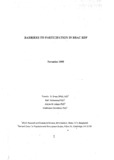Barriers to participation in BRAC RDP
Citation
Nath, T. G. E. R., Rafi Mohammed, Adams, Alayne M., & Chowdhury, M. (1995, November). Barriers to participation in BRAC RDP. Research Reports (1995): Social Studies, Vol – XI, 1–45.Abstract
As part of the BRAC RDP Impact Assessment Study (lAS), a participatory wealth ranking
exercise stratified households into four socio-economic groups: groups 1 and 2 being wellendowed
with land, assets and generally without survival worries; group 3 households having
marginal land holdings, minimal assets and resources devoted exclusively to survival; and finally a
"4th group" in which household viability is threatened by poverty, ill-health and other adversities.
Although both 3rd and 4th group households are eligible to participate in BRAC RDP, concern
about the accessibility of the Programme to the destitute "4th group" along with a general
ignorance about the characteristics of this group, provided the rationale for this study. Its purposes
are: 1. to establish the prevalence of household poverty in rural Bangladesh and the rate of BRAC
RDP participation; 2. to elicit the circumstances which inhibit the "4th group" from participating
in BRAC RDP; and 3. to identify changes in the structure of RDP, or the need for new initiatives,
to improve their well-being.
In August through to October 1994, a field survey was undertaken in five well-established, good
functioning RDP Area Offices (AOs). Ten percent of the Village Organizations (VOs) in each of
these AOs were selected for the sample (78 VOs in 55 villages). Key informants enumerated all
households in the sample villages, and, employing Rapid Rural Appraisal (RRA), ranked them
into 3 wealth groups: 1. wealthy households; 2. poor households: and 3. very poor households
( 11,805). In each village, 30 households were selected for interview--! 0 RDP members. I 0
eligible non-members, 5 former members, and 5 ineligible or non-target group (NTG) households.
Structured questionnaires containing sections on household composition, health, past crises. socio-
economic status and BRAC membership were administered to 1637 households.

